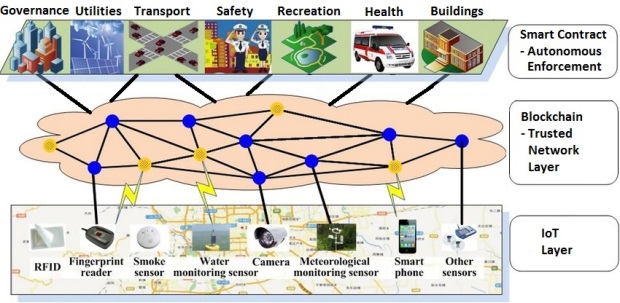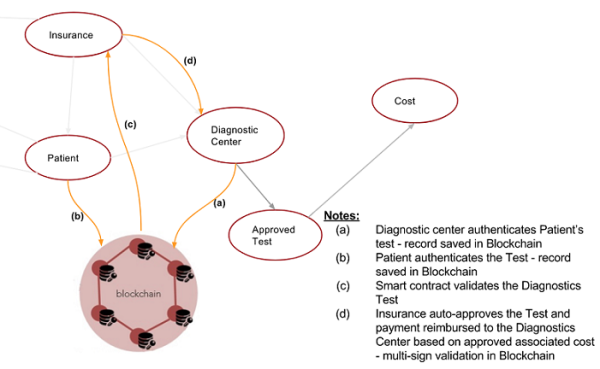I. Introduction
What are Smart Cities?
Earlier, as mankind evolved, cities were developed based on the industrialization and / or by the river-banks, where water and livestock was available in plenty. While in the modern era efforts are on to build cities on the corridors of economic growth by providing core infrastructure which is the main impetus for smart cities. The core infrastructure includes, water, electricity, healthcare, education, safety, security, transportation, sustainable environment, waste management and accommodation. The prime objective of a Smart City is in providing core infrastructure and to give a decent quality of life to its populace. A smart city uses information technology to integrate and manage physical, social, and business infrastructures in order to enable better services to its people while ensuring efficient and optimal utilization of available resources. With the widespread use of connected devices, or Internet of Things (IoT) and creation of a trusted network aka, Blockchain, new innovative solutions can be enabled for direct interaction between the government and its people. The new initiative of the Government of India (GoI) by earmarking tier-II cities to be developed as Smart Cities there is a strong emphasis on building the core infrastructure and enabling transparency in the governance. The new technology frameworks provide high potential for enabling this idea into reality.
What is IoT?
The concept of IoT is the network of devices, appliances, vehicles and other accessories that we use daily, embedded with software and hardware so as to collect data and exchange information. Each of these devices feature an IP address so that it can be located, monitored and managed from anywhere. It is being developed to make the internet even more immersive and pervasive so that a wide variety of devices such as, home appliances, surveillance cameras, monitoring sensors, actuators, displays, vehicles, and so on, can all be under one network of connected devices. Extending this concept of all connected devices in a home, to all homes in a locality and all localities in a city makes it a Smart City application. As we can see IoT is fundamental core and integral part of a Smart City implementation. Parking tickets and traffic violations received in mail after detection in street CCTVs is a simple example of IoT in practice.
How does Blockchain help?
Blockchain offers a technology to establish transparency and security, as one of its main characteristics is a neutral, non-hierarchical, accessible and secure database. It is a decentralized technology where the database is managed by the network and there is no central authority. The participating nodes in the network keep copies of the transactions and agree on the changes made by consensus. This makes it ideal for preventing corruption and creating transparency in dealings with the government among others. Just as there are bank records for financial transactions, Blockchain is record of digital transactions; it is also called Internet of Transactions (IoTrans). Incorporating Blockchain into the development of smart cities will make it possible to have a cross-cutting platform that connects the cities’ different services, adding greater transparency and security to all processes. Blockchain can be used for a variety of applications, such as tracking the ownership of real estate assets, authenticity of legal heirs and wills, voting rights, etc.
Blockchain and IoT is a marriage made in heaven to deliver Smart Cities as a reality. IoT as we can see connects each and every device that can be managed, while the trusted network based on Blockchain can enable deployment of smart contracts that can monitor the operations and roll-out services in an efficient and effective way. Smart contract can implement the policies autonomously thereby eliminating human intervention and the associated mistakes and / or malpractices.
II. Application Landscape
As we have seen in the introduction, there is a huge potential for developing new applications as we build smart city. The following sections briefly touch upon the areas and dwell on the applications’ overview that are being deployed in the smart cities globally.

• Governance: Transparency and accountability is of utmost importance in building application for good governance and public utilization:
o Land Registrations: Land registration department is where one agency operates any kind of land dealing and transactions, and once it is computerized, it can be subject to change. But if a land transaction is recorded on a Blockchain based network, it cannot be tampered. Complete details of the land, like the owner, income, lineage, etc. can be retained along with a change history. If a bank wants to lend a loan, this land information can be checked in this Blockchain store to establish the identity and to decide if sanctioning a loan is viable or not. This not only improves efficiency, cuts down on dubious deals but also reduces cost of operations.
o E-Voting: Securing and guarding democratic process and conducting free and fair election is a daunting task. India has time and again proved that it can deliver on this by adopting to new platform and technologies. We have moved from paper ballot to electronic voting machines, however, these too are under severe criticism of being tamper prone. In order to build a fool-proof system we can leverage the Blockchain framework to make voting a secure and trustworthy mechanism.
• Utilities: Public distribution system are frequent targets of vandalism and pilferage, be it power, water or gas transmissions. In order to make distribution leak-proof, we can deploy self-monitoring devices that are managed by smart contracts which can cut-off supply on detection of unaccounted usage / loss. For example, more than 40% clean water loss can be prevented by deploying such systems in a smart city launch.
• Transport: Traffic monitoring and fast routes to prevent congestions and to divert vehicles away from points of incidents using CCTVs and routing algorithms based smart contracts. Driverless vehicles and safe transport based on commuter density for improved performance and efficiency in public transport systems.
• Safety: Alert mechanisms to protection forces and motion detection to reduce thefts / incidents in high security zones and remote locations. Ability to provide higher public safety in congestion areas by use of smart devices and video recordings. Smart contract based rapid action deployment built on Blockchain framework. Fire detection and automated alerts to concerned authorities to prevent and stop spread of fire accidents.
• Waste Management: Using waste bin level monitors to alert garbage trucks to points of fill rather than routine trips which can reduce more than 50% garbage collection costs. Improved sanitary levels by continuous removal of waste from high dump areas.
• Health: Prevent drug addiction and use by drug trace-ability from drug manufacturers, warehouses, retails and patients – only authentic patients can be consuming drugs that are prescribed to them, no spurious users. Ability to develop and administer precision medicine based on individual patient needs and characteristics. Enable researchers and providers collaborate without loss of patient privacy. Wide spread use of Electronic Health Records (EHR) across multiple platforms and applications, no loss or duplication of patient data. Patient data access restricted to authenticated users.
• Buildings: Facilities management and maintenance industries are changing with the advent of new technology platforms and for enhancing operations, safety, security and customer satisfaction. The diverse nature and volume of machinery in facilities include cooling / heating systems, electrical supply, deep freezers, escalators / elevators, IT systems, CCTVs, motion detections, etc. IoT platform is the answer to most of facility management issues and for optimal and efficient usage. Device identity and security are the key factors for building maintenance and to prevent cyber attacks. Smart contract based policy deployment can reduce costs in power consumption and operations of up to 50%.
• Indian Context: In digital India, we already have Aadhar identity which can be used in conjunction with the Blockchain framework for smart governance in trade finance. It is also very useful for universities and educational institutions for validating students and storing their education transcripts. Blockchain based sharing of education transcripts will help the students move to newer graduate programs and to pursue higher degrees. Potential employers can use this platform for background checks and verification without the need for any third party agency.
III. Plausible Challenges
When automation and smart cities become fully functional, many experts feel that there is lack of complete legal framework for policy regulation of IoT networks. For example, questions remain as to who is responsible in case of defaults and service disruptions, is it network provider, device manufacturer, monitoring authority or the user of technology. Currently, we are seeing instances of these legal issues being played out. For example, in the driver-less transport systems that are being tried out in the west, in case of accidents / collisions, who is to be blamed, the car manufacturer? Software developer? Or the satellite systems which are guiding the vehicle in real-time? The security framework for such extensive transmission of data over networks will also need implementation for protection from cyber-crimes and identity thefts.
Some potential issues and areas to ponder about before this new technology can be adopted to real life issues:
Attitudinal Change: As the saying goes, “Power corrupts and absolute power corrupts absolutely”, with the objective of making all decisions and decision making processes transparent, how will the people in power take this? Will they sit back and let autonomous ‘bots’ play it out while they watch their power grip slip away from their delicate hands? Are they willing to be dictated by the mob justice and social media?
Security and Privacy: Although Blockchain ensures secure transactions there are many potential loopholes that need to be plugged before making business applications go live.
Regulations: Now the decisions are being taken autonomously by smart contracts, it needs to be defined who is responsible in case of service lapses. There are many collaborating technologies and platforms, so identifying the real defaulter in the complex scheme of things is something that needs due diligence and identification before being rolled out to the general public.
Capital Costs: Adopting new technology means new hardware and network requirements, which mean higher start-up costs and installation. Funding is a biggest challenge to build smart city and major player apart from the government need to come forward and pitch in this endeavor.
New Technology: Being the cutting edge of technology, it is unsure how the platform scales up to live production issues. There are still areas of concern on response time and ability to handle thousands of transactions.
Data Sensors: Smart cities are based on data and for data collection we will need sensors. Sensors are needed to see, record, and feel on people’s behalf. We will need millions of sensing devices quickly to collate data and make informed decisions. It the data is not adequate, the decisions will be half-baked.
Smart Cities require smart people who can actively participate in defining governance and formulating reforms. Smart people need to involve in decision making and deployment of smart solutions which are fair and based on factual data which make Smart city implementations worth-while.

